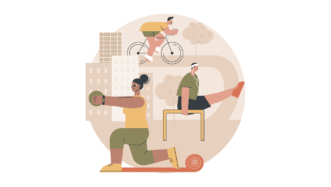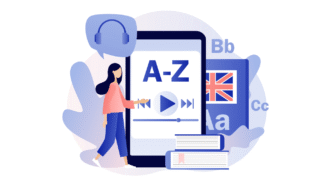LESSON OVERVIEW
The main objectives of this ESL lesson are to:
- learn vocabulary to discuss families, friends, and colleagues;
- practise Present Simple forms of ‘to be’ by talking about people;
- listen to a recording, describe people in photos, and analyse a family tree.
This lesson helps students practise Present Simple forms of ‘to be’! Students learn vocabulary to talk about their families and friends. They discuss their loved ones and colleagues using correct pronouns and forms of the verb ‘be’. They identify photos by listening to a recording and describe the people in their own photos using target language and grammar. Students get lots of practice identifying who and where people are, and how they’re feeling, using the verb ‘be’.
WARM-UP AND DISCUSSION
The lesson with Present Simple forms of ‘to be’ starts with a warm-up. Students complete a sentence with their name.Then, they read more sentences and say which is true for them today (e.g. I’m happy/tired). Next, they look at a family tree and match what the people say with the tree. Then, they look at the tree again and choose the correct words (e.g. dad/brother). They look at the family again and write one more sentence each family member could say (e.g. ____ is my daughter). After that, they read words and categorise them by putting two in each column of a table (e.g. work – boss, colleagues). Next, they choose sentences and complete the gaps with information about people they know. (e.g. ____ is my sister/mum/teacher).
PRESENT SIMPLE FORMS OF ‘TO BE’
The lesson continues with a recording. Students listen and identify two photos mentioned. Next, students read sentence pairs and choose the correct sentence. Afterwards, they listen again and check their answers. Then, they match people and things with pronouns (e.g. Adam and Olivia – they). Then, the lesson introduces Present Simple forms of ‘to be’. Students look at the sentences from the previous exercise and complete gaps with forms of the verb ‘be’. Then, students look at a photo and complete gaps correctly (e.g. it’s, we’re, you’re). They choose four people from a box (e.g. my family, my brother) and write two sentences about each, using words and phrases in two other boxes to help. Students finish practising present simple forms of ‘to be’ using photos of their family, friends or colleagues from their phone. They tell their partner about the people in the photo, using ideas and additional language provided.
HOMEWORK/REVISION
This lesson plan also includes an additional task that you can use as homework or revision. In the task, students create words using the letters in brackets. Then, they choose the correct words or phrases in bold using what they’ve learned about the verb ‘be’. The task is available in the teacher’s version of the worksheet. You can print it and hand it out to your students. It’s also included in the e-lesson plan.
WORKSHEETS
Subscribe to unlock these and many other Standalone lesson lesson plans with the Unlimited plan
Subscribe













Found this material to be un-even and confusing. The link in the pdf didn’t work as well.
Hi Jack! We’d appreciate some details – please drop us a line at [email protected].
We’ve checked the links in the pdfs and they seem to be working.
There is an error in slide 19. Photo 1 is B, and Photo 2 is C not A.
Hi! The second speaker (Photo 2) says: ‘It’s a photo of my colleagues, Ava and Mateo. They’re at work.’ – so it can’t be photo C because there are three people in it. So the answers are correct 🙂
Hi,
I normally use the A1-A2 lessons because one of my groups requested that we start from the beginning. They are quite useful. My only remark is that the 60-minute material took us only 30 minutes to complete. For this reason, I frequently expand the slides. I appreciate how difficult it is to generate interactive materials at the beginner level, but could they be expanded with additional activities or audio resources?
Thank you.
Hi, thanks for the feedback! It’s great to hear the lessons are useful.
We create A1 materials with elementary students in mind so the lessons might not be enough for a 60-minute session for false beginners. But to answer your question: we might create some A1 worksheets with extra comprehension practice and/or other activities. We just started creating A1 lesson plans last year and we’re willing to try out different formats and ideas, so thanks for sharing!
I have subscribed and i still can’t open the worksheets
Hi! I see that you have the Free plan and this lesson is only available for Unlimited users. You can upgrade here or browse free lessons here.